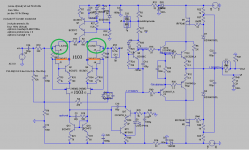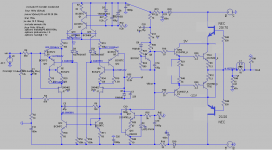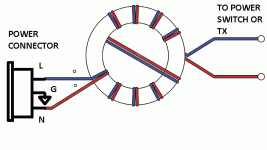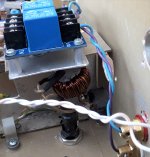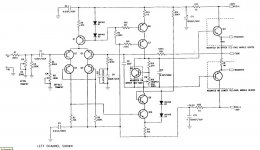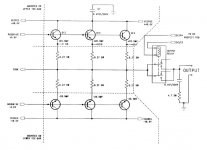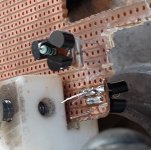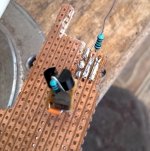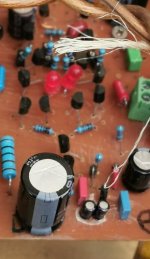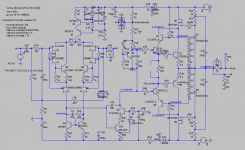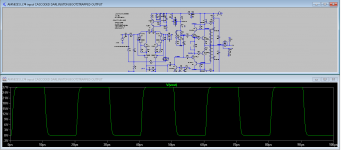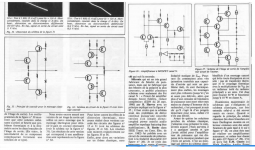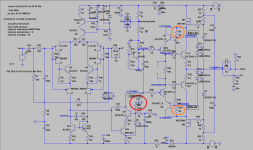R51, C20 (and many other parts) are not needed
R21 and R48 should go to output
OK. Thank you. I'll check it.
BTW, sometimes reality show us how dumb we are...I discovered that my cheap multimeter has the 200VDC range (and only that) malfunctioning, so it is not 50V supplies but 44V supplies as I previewed...
One channel has sub 10mV offset spontaneously. The other has 24mV.
I am adding a speaker protection and finishing the case.
At 90mA bias current, heatsinks are cold so I decided to place them horizontally and not vertically, as was my original plan. It looks better also.
Cheers,
M.
Last edited:
Guys, in case you want to test a JFET input AMNESIS, my recommendation, after making the due corrections, is that the "driver" JFET of the CFP be a LJ74 or other "audio" JFET, since the reverse in positions from J103 to LJ74 improved significantly the sound:improved definition and sweetness of sound in general and highs in particular; improved colors; improved dynamics.
Fortunately, I still have two matched "quartets" of LJ74. 😎 🙂
The next JFET (J3-J4 in the schematic), bootstrapping element inside the hybrid CFP, I guess can be any good JFET. I show also alternative connection for its gates.
Cheers,
M.
Edit: I attach the updated VFET version. Highly recommended.
Fortunately, I still have two matched "quartets" of LJ74. 😎 🙂
The next JFET (J3-J4 in the schematic), bootstrapping element inside the hybrid CFP, I guess can be any good JFET. I show also alternative connection for its gates.
Cheers,
M.
Edit: I attach the updated VFET version. Highly recommended.
Attachments
Last edited:
At this pace, building a decent amplifier will take twenty years.
It doesn't matter.
Creativity is God given.
We cannot help but keep creating, even if we err...
DIYaudio forum is full of very, very creative people, meaning God is present here an He loves this site. 😉
This time is the time of really risking the last bit of confidence you may still have in my humble self, in all you Magnanimity. 😀
To push the Amnesis more into perfection realm, I resurrected the "Reisert Balun", which I believe is the correct term. A trick I learnt in the early 2000's from a pro upgrade site, if I remember correctly, dedicated to digital transport upgrades. Since, I used it on noisy digital units with great effect, but lately I used it on my Otari R2R and now on my amps. The perfect one is made from a ring whose material can be useful into the tens of KHz (I forgot the exact one) and winded with OCC copper enameled wire, but, since I ran out of these noble materials, I have used common type (Chilean 😎) enameled copper and ferrite rings rescued from burnt PC's SMPS to good effect.
Be Brave, use Brave browser...ahem, I meant, be brave, try this trick and be amazed. 😎
I am using it everywhere, in every unit of the chain. I even consider using it on other home appliances.
For example: digital source-->TVC-->Amnesis; or Transport--> digital processor-->DAC-->TVC-->Amnesis.
I won't describe the effect not to influence your young minds. 😉
Cheers,
M.
To push the Amnesis more into perfection realm, I resurrected the "Reisert Balun", which I believe is the correct term. A trick I learnt in the early 2000's from a pro upgrade site, if I remember correctly, dedicated to digital transport upgrades. Since, I used it on noisy digital units with great effect, but lately I used it on my Otari R2R and now on my amps. The perfect one is made from a ring whose material can be useful into the tens of KHz (I forgot the exact one) and winded with OCC copper enameled wire, but, since I ran out of these noble materials, I have used common type (Chilean 😎) enameled copper and ferrite rings rescued from burnt PC's SMPS to good effect.
Be Brave, use Brave browser...ahem, I meant, be brave, try this trick and be amazed. 😎
I am using it everywhere, in every unit of the chain. I even consider using it on other home appliances.
For example: digital source-->TVC-->Amnesis; or Transport--> digital processor-->DAC-->TVC-->Amnesis.
I won't describe the effect not to influence your young minds. 😉
Cheers,
M.
Attachments
Last edited:
I've been asked how many turns for the "Reisert Bifilar Balun"?
Based on recent listening, I believe the more the better. I will probably re-wind some and see/listen.
I appears that R and C vary with N (n° of turns) but L vary with N squared, which apparently brings the resonant point lower...I hope this is a good thing 😱
Anyway, there you have probably the best and cheapest upgrade of them ALL.
Best wishes,
M.
Based on recent listening, I believe the more the better. I will probably re-wind some and see/listen.
I appears that R and C vary with N (n° of turns) but L vary with N squared, which apparently brings the resonant point lower...I hope this is a good thing 😱
Anyway, there you have probably the best and cheapest upgrade of them ALL.
Best wishes,
M.
Too true Max. That's why I delve. No expert but gee I learn a lot.Anyway, playing with electronics is a fun hobby and a window to higher accomplishments, I hope.
With unconditional Love,
M.
Regards John L.
Too true Max. That's why I delve. No expert but gee I learn a lot.
Regards John L.
Thank you!
I like your Nickname. 😀
Only those that know that they don't know, can learn. 😎
Those that think they know already all-there-is, won't learn sh***.
Best wishes,
M.
Hello
Here's an interesting amp, cascode input and vas, it should have low memory distortions. It's in two part, the amp and the power output.
Any opinions about it ?
Thank
Bye
Gaetan
Here's an interesting amp, cascode input and vas, it should have low memory distortions. It's in two part, the amp and the power output.
Any opinions about it ?
Thank
Bye
Gaetan
Attachments
Last edited:
Nice.
But remember that adding just one more BJT/JFET and one more resistor can transform the input into a cascoded Sziklai input, to get the full effect of the LTMD circuit, as shown by Peufeu et alter. 😉
I also consider separating the input + VAS and the output section to test more easily different output options.
VFET cascoded Darlington output is the most transparent to date. I miss some midrange/midbass exuberance though, so I will test "QUAD" with VFETs soon. 😎
Best wishes,
M.
PS: I am testing now John Brown's, AKA -ECdesigns-, "Electro-Tos" digital connection between transport and DAC. Maybe the invention/discovery of the decade. 🙂
But remember that adding just one more BJT/JFET and one more resistor can transform the input into a cascoded Sziklai input, to get the full effect of the LTMD circuit, as shown by Peufeu et alter. 😉
I also consider separating the input + VAS and the output section to test more easily different output options.
VFET cascoded Darlington output is the most transparent to date. I miss some midrange/midbass exuberance though, so I will test "QUAD" with VFETs soon. 😎
Best wishes,
M.
PS: I am testing now John Brown's, AKA -ECdesigns-, "Electro-Tos" digital connection between transport and DAC. Maybe the invention/discovery of the decade. 🙂
Hello
Maby one simple way to reduce memory in the LTP input stage is to use transistors with larger dies, having higher thermal mass, you can use TO-126 and larger transistors like ksa1381 and ksc3503.
Any opinions about that ?
Thank
Bye
Gaetan
Maby one simple way to reduce memory in the LTP input stage is to use transistors with larger dies, having higher thermal mass, you can use TO-126 and larger transistors like ksa1381 and ksc3503.
Any opinions about that ?
Thank
Bye
Gaetan
Hi,
Good idea. Especially for the critical input PNP BJTs.
Two commentaries though.
Firstly, doesn't bigger size correlate with bigger size of the junction, meaning increased charge needed?
Secondly, the simulations so far show that our approach for the input indeed has very low LTMD, compared with the plain input 😎 through pursuing constant power.
Anyway, it should be easy to test. Remember, one can build a cascoded CFP on a little board an insert it instead of the stock differential amplifier input transistors, to quickly test the worth of Hephaïstos approach... 😉 RIP.
RIP.
Cheers,
M.
Good idea. Especially for the critical input PNP BJTs.
Two commentaries though.
Firstly, doesn't bigger size correlate with bigger size of the junction, meaning increased charge needed?
Secondly, the simulations so far show that our approach for the input indeed has very low LTMD, compared with the plain input 😎 through pursuing constant power.
Anyway, it should be easy to test. Remember, one can build a cascoded CFP on a little board an insert it instead of the stock differential amplifier input transistors, to quickly test the worth of Hephaïstos approach... 😉
 RIP.
RIP.Cheers,
M.
Attachments
Last edited:
Hello
After checking a bit, higher currents transistors requires more drive on the base and this loads down the source and tends to increase noise. So it's no good for the input transistors, but it's good for vas transistors. So I will use 2N5401 and 2N5551 (600 ma. collector current) as I was doing for the input transistors, and I will use ksc3503 as I was doing for the vas.
Bye
Gaetan
After checking a bit, higher currents transistors requires more drive on the base and this loads down the source and tends to increase noise. So it's no good for the input transistors, but it's good for vas transistors. So I will use 2N5401 and 2N5551 (600 ma. collector current) as I was doing for the input transistors, and I will use ksc3503 as I was doing for the vas.
Bye
Gaetan
Hi dear Gaetan,
That is what I was talking about, someway.
Anyway, be sure to have some room for the exploration of mods because I am sure you will want to upgrade to Amnesis style after your successful build. 😀
Best micro and macro dynamics!
We have explored the VAS transistor, cascoded, and decided that MPSA18 or N2221(was it that?) sound better than 5551, cascoded with any mid power T of your preference. 😉 Simulation also show better results, so go figure.
Edit: in our experience the Casoded BJT for the VAS needs to sit >3.5VDC above the little VAS transistor for optimal function. That is why I chose 2 yellow LEDs. Lower power headroom in exchange for best sound.
Edit n°2: you may also want to test Hagemann Vbe multiplier, which is better than the plain, usual option, IMHO.
Best wishes of success,
M.
That is what I was talking about, someway.
Anyway, be sure to have some room for the exploration of mods because I am sure you will want to upgrade to Amnesis style after your successful build. 😀
Best micro and macro dynamics!
We have explored the VAS transistor, cascoded, and decided that MPSA18 or N2221(was it that?) sound better than 5551, cascoded with any mid power T of your preference. 😉 Simulation also show better results, so go figure.
Edit: in our experience the Casoded BJT for the VAS needs to sit >3.5VDC above the little VAS transistor for optimal function. That is why I chose 2 yellow LEDs. Lower power headroom in exchange for best sound.
Edit n°2: you may also want to test Hagemann Vbe multiplier, which is better than the plain, usual option, IMHO.
Best wishes of success,
M.
Last edited:
Hello
I'm french speaking, sometime I don't understand everything wrote in a post.
Thank
bye
Gaetan
I'm french speaking, sometime I don't understand everything wrote in a post.
Thank
bye
Gaetan
Hi dear Gaetan,
That is what I was talking about, someway.
M.
Hello
I'm french speaking, sometime I don't understand everything wrote in a post.
Thank
bye
Gaetan
Pas de problème ici, mor cher Gaetan, sauf que les règles de DIAudio obligent à écrire (aussi) en Anglais... 🙂
No problem, dear. You're welcome.
M.
Latest recommendation, as per SONY's TA-N7 and Gaetan's amp, I added some nice Epcos 47nF/630V film caps right from Drain pins to Ground for the NEC VFETs (also recommended for the cascoded MOSFETs) for the cascoded outputs. In fact, I should have done this long ago...
Another delicious mod done on two of my Amnesis front end PS is Super E-cap a couple of 100nF/50V Black Gates. That is simpler than making a separate, regulated supply for the front end and VAS, which should come at some point. 😎
Guys, I cannot state enough to aim for the best supply possible for this first stages of the amp, be it through judiciously // caps or other strategy, like C-L-C or others. It should make a big effect in sound quality.
Best wishes of joy for you all, and stay Grounded in these interesting times 🙂
I AM M. 😎
Another delicious mod done on two of my Amnesis front end PS is Super E-cap a couple of 100nF/50V Black Gates. That is simpler than making a separate, regulated supply for the front end and VAS, which should come at some point. 😎
Guys, I cannot state enough to aim for the best supply possible for this first stages of the amp, be it through judiciously // caps or other strategy, like C-L-C or others. It should make a big effect in sound quality.
Best wishes of joy for you all, and stay Grounded in these interesting times 🙂
I AM M. 😎
Attachments
Last edited:
I guys. How is all going?
The chaos is going to become a little more chaotic until the convergence. 😀
Well, while daily enjoying my 3 Amnesis amps (6 channels in total) there is one channel that is prone to oscillation on the QUAD bootstrapped amp, under specific conditions:big system number two with anaconda like speaker cables and only when someone pull-on the lights on the room, as the interruptor sparks!
The Darlington Output with VFETs bootstrapping is unconditionally stable but is a little too thin and polite for my taste,the QUAD being bold, generous and dynamic. I am not on the mood to modify/upgrade it to a QUAD as I lack a functioning scope. But, I remember Hephaïstos idea of internally cascodying the Darlingtons (and Siklays) so I gave it a try and it works, looks very stable and has low distortion. And it is also easier to implement. The Vref for the cascodying BJT needs to be at least 3.6V to full output, through several diodes or two yellow LEDs. The VFETs automatically set to 12V at the present current bias, so I changed the bias (zeners) to the Mosfets in this particular example to imitate the VFET amp expected performance.
I hope you like it.
Best wishes,
M.
The chaos is going to become a little more chaotic until the convergence. 😀
Well, while daily enjoying my 3 Amnesis amps (6 channels in total) there is one channel that is prone to oscillation on the QUAD bootstrapped amp, under specific conditions:big system number two with anaconda like speaker cables and only when someone pull-on the lights on the room, as the interruptor sparks!
The Darlington Output with VFETs bootstrapping is unconditionally stable but is a little too thin and polite for my taste,the QUAD being bold, generous and dynamic. I am not on the mood to modify/upgrade it to a QUAD as I lack a functioning scope. But, I remember Hephaïstos idea of internally cascodying the Darlingtons (and Siklays) so I gave it a try and it works, looks very stable and has low distortion. And it is also easier to implement. The Vref for the cascodying BJT needs to be at least 3.6V to full output, through several diodes or two yellow LEDs. The VFETs automatically set to 12V at the present current bias, so I changed the bias (zeners) to the Mosfets in this particular example to imitate the VFET amp expected performance.
I hope you like it.
Best wishes,
M.
Attachments
Last edited:
Update:
I think we may have a winner...I did the upgrade showed above. It is superior to the stock Darlington, which sounds flat and unninvolving by comparison. BUT it is unstable. I am trying the following circuit which is running stable so far, and it is easier to build. Two yellow LEDs give me 4V, which is the minimum recommended.
Remember, mine has VFETs instead of MOSFET as cascoded output.
It recovered the depth and focus, the energy rearranging as true music.
Apart, I found this site about L'Audiophile, French magazine, which lists links to Hephaïstos articles. Posted the link and a couple of diagrams that served as inspiration.
index
Folks, I am simply convinced that cascoded/bootstrapped circuits sound natural.
If it weren't for the oscillation risk... 🙁
Cheers,
M.
PS: I also added 47nF from heatsink to ground or vice-versa.
I think we may have a winner...I did the upgrade showed above. It is superior to the stock Darlington, which sounds flat and unninvolving by comparison. BUT it is unstable. I am trying the following circuit which is running stable so far, and it is easier to build. Two yellow LEDs give me 4V, which is the minimum recommended.
Remember, mine has VFETs instead of MOSFET as cascoded output.
It recovered the depth and focus, the energy rearranging as true music.
Apart, I found this site about L'Audiophile, French magazine, which lists links to Hephaïstos articles. Posted the link and a couple of diagrams that served as inspiration.
index
Folks, I am simply convinced that cascoded/bootstrapped circuits sound natural.
If it weren't for the oscillation risk... 🙁
Cheers,
M.
PS: I also added 47nF from heatsink to ground or vice-versa.
Attachments
Last edited:
- Home
- Amplifiers
- Solid State
- The AMNESIS amp: a good amplifier, like a gentleman, has no memory.
